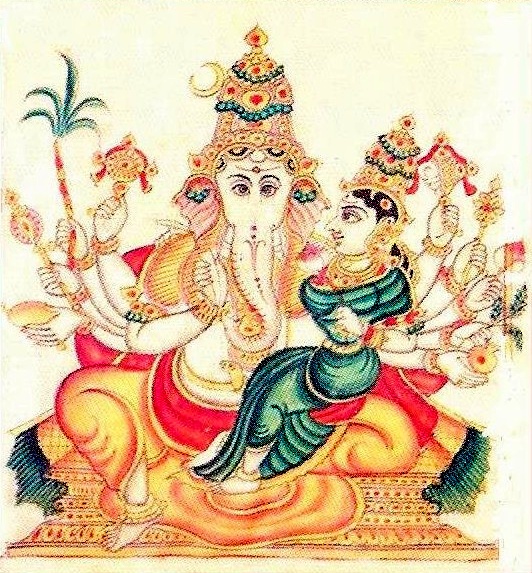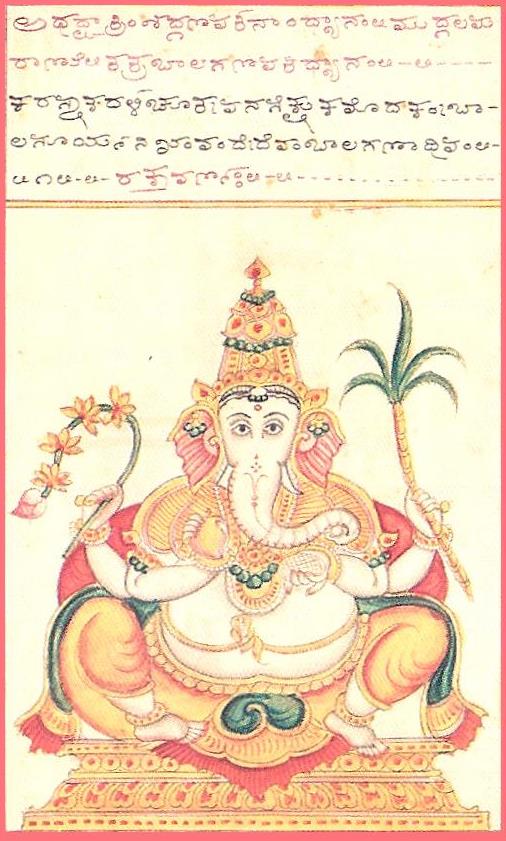|
Ganapatya
Ganapatya is a denomination of Hinduism that worships Ganesha (also called Ganapati) as the Parabrahman, Saguna Brahman.Ganapatyas Article from PHILTAR, Division of Religion and Philosophy, St Martin's College Beliefs The worship of is considered complementary with the worship of other deities. Hindus of all sects begin prayers, important undertakings, and religious ceremonies with an invocation of Ganesha, because of Ganesha's role as the god of beginnings. But although most Hindu sects do revere Ganesha, the Ganapatya sect goes further than that, and declares Ganesha to be the supreme being. Ganapatya is one of the five principal Hindu sects which focus on a particular deity, along ...[...More Info...] [...Related Items...] OR: [Wikipedia] [Google] [Baidu] |
Ganesha
Ganesha or Ganesh (, , ), also known as Ganapati, Vinayaka and Pillaiyar, is one of the best-known and most worshipped Deva (Hinduism), deities in the Hindu deities, Hindu pantheon and is the Supreme God in the Ganapatya sect. His depictions are found throughout India. Hindu denominations worship him regardless of affiliations. Devotion to Ganesha is widely diffused and extends Ganesha in world religions, to Jains and Buddhists and beyond India. Although Ganesha has many attributes, he is readily identified by his Asiatic Elephant, elephant head and four arms. He is widely revered, more specifically, as the remover of obstacles and bringer of good luck; the patron of The arts, arts and Science, sciences; and the Deva (Hinduism), deva of intellect and wisdom. As the god of beginnings, he is honoured at the start of rites and ceremonies. Ganesha is also invoked during writing sessions as a patron of letters and learning., Vigna means obstacles Nasha means destroy. These ideas ar ... [...More Info...] [...Related Items...] OR: [Wikipedia] [Google] [Baidu] |
Morgaon Ganesha Temple
Shri Mayureshwar Mandir or Shri Moreshwar Temple is a Hinduism, Hindu Hindu temple, temple (''mandir'') dedicated to Ganesha, god of wisdom. It is located in Moragaon in Pune District, about 65 km away from Pune city in the Indian state of Maharashtra. The temple is the starting and ending point of a pilgrimage of eight revered Ganesha temples called Ashtavinayaka. Moragon is the foremost centre of worship of the Ganapatya sect, which considers Ganesha as the Supreme Being. A Hindu legend relates the temple to killing of the demon Sindhura by Ganesha. The exact date of building of the temple is unknown, though the Ganapatya saint Morya Gosavi, Moraya Gosavi is known to be associated with it. The temple flourished due to the patronage of the Peshwa rulers and descendants of Moraya Gosavi. Religious significance The Morgaon temple is the starting point of the pilgrimage of eight revered temples of Ganesha, around Pune. The temple circuit is known as Ashtavinayak ("Eight Gan ... [...More Info...] [...Related Items...] OR: [Wikipedia] [Google] [Baidu] |
Morya Gosavi
Morya Gosavi or Moraya Gosavi () alias Moroba Gosavi was a prominent saint of the Hindu Ganapatya sect, which considers Ganesha as the Supreme God. Morya Gosavi is considered the chief spiritual progenitor of the Ganapatyas and has been described as the "most famous devotee" of Ganesha. The lifetime of Morya Gosavi is speculated between the 13th to 17th century. Numerous legends recall his life. Morya became devoted to Ganesha when he started visiting the Morgaon temple of Ganesha. It is believed that due to the hindrance in Morya's services to the god in the popular Ganesha shrine, Ganesha told Morya that he would appear in Chinchwad for Morya to worship, so Morya moved from Morgaon to Chinchwad, where Morya built a Ganesha temple. Consequently, Morya took '' sanjeevan samadhi'' by burying himself alive in his tomb. Morya had a son called Chintamani, venerated as a living incarnation of Ganesha and addressed as '' Dev'' (god). Chintamani was succeeded by six more ''Dev''s. ... [...More Info...] [...Related Items...] OR: [Wikipedia] [Google] [Baidu] |
Mahaganapati
Mahaganapati (, ), literally "Ganesha, the Great"), also spelled as Maha Ganapati, and frequently called Mahaganadhipati, is an aspect of the Hindu god Ganesha. He is the representation of Ganesha as the Supreme Being Paramatman and is the most important deity of the Ganesha-centric Ganapatya sect. He is one of the most popular of the thirty-two forms of Ganesha, worshipped as a representation of the ultimate truth Para brahman. Mahaganapati is depicted as elephant-headed with ten arms carrying various objects and is accompanied by a goddess. Iconography Like all aspects of Ganesha, Mahaganapati has an elephant head. Sindoor, is generally used for his red colour, in depictions. His colour is a reference to the dawn. He is often depicted with a third eye on his forehead, a crescent moon over his head, ten arms which hold; a lotus, a pomegranate fruit, a gada (mace), a chakra (discus), his own broken tusk, a pasha (noose), a jewelled water vessel or a pot of jewels, a blue lo ... [...More Info...] [...Related Items...] OR: [Wikipedia] [Google] [Baidu] |
Ganesha Sahasranama
The Ganesha Sahasranama () is a list of the names of Hindu deity Ganesha (). A sahasranama is a Hindu hymn of praise in which a deity is referred to by 1,000 or more different names. Ganesha Sahasranamas are recited in many temples today as a living part of Ganesha devotion. There are two different major versions of the Ganesha Sahasranama, with subvariants of each version. One major version appears in chapter I.46 of the Ganesha Purana (), an important scripture of the Ganapatya (). This version provides an encyclopedic review of Ganesha's attributes and roles as they were understood by the Ganapatya. A Sanskrit commentary on a subvariant of this version of the Ganesha Sahasranama was written by Bhaskararaya. (). Bhaskararaya titles his commentary Khadyota ("Firefly"), making a play on words based on two different meanings of this Sanskrit term. In his opening remarks Bhaskararaya says that some will say that because the commentary is very brief it is inconsequential like ... [...More Info...] [...Related Items...] OR: [Wikipedia] [Google] [Baidu] |
Para Brahman
''Para Brahman'' or ''Param Brahman'' () in Hindu philosophy is the "Supreme Brahman" that which is beyond all descriptions and conceptualisations. It is described as beyond the form or the formlessness (in the sense that it is devoid of Maya) that eternally pervades everything, everywhere in the universe and whatever is beyond. Para Brahman is conceptualised in diverse ways. In the Advaita Vedanta tradition, the Para Brahman is a synonym of ''nirguna brahman'', i.e., the attribute-less Absolute. Conversely, in Dvaita Vedanta and Vishistadvaita Vedanta traditions, the Para Brahman is defined as ''saguna brahman'', i.e., the Absolute with attributes. In Vaishnavism, Shaivism, and Shaktism, Vishnu, Shiva, and Adi Shakti respectively are Para Brahman. Mahaganapati is held to be Para Brahman by the Ganapatya sect, Kartikeya by the Kaumaram. Etymology ''Para'' is a Sanskrit word that means "higher" in some contexts, and "highest or supreme" in others. ''Brahman'' in Hindui ... [...More Info...] [...Related Items...] OR: [Wikipedia] [Google] [Baidu] |
Herambasuta
Herambasuta (Devanagari:हेरम्बसुत, IAST:) was an Indian Tantric yogi who belonged to the vamachara Ganapatya Ganapatya is a denomination of Hinduism that worships Ganesha (also called Ganapati) as the Parabrahman, Saguna Brahman. [...More Info...] [...Related Items...] OR: [Wikipedia] [Google] [Baidu] |
Sahasranama
' is a Sanskrit term which means "a thousand names".Sir Monier Monier-Williams, ''sahasranAman'', A Sanskrit-English Dictionary: Etymologically and Philologically Arranged with Special Reference to Cognate Indo-European Languages, Oxford University Press (Reprinted: Motilal Banarsidass), It is also a genre of stotra literature, usually found as a title of the text named after a deity, such as Vishnu Sahasranāma, wherein the deity is remembered by 1,000 names, attributes or epithets. As stotras, Sahasra-namas are songs of praise, a type of devotional literature. The word is a compound of ' "thousand" and ' "name". A Sahasranāma often includes the names of other deities, suggesting henotheistic equivalence and/or that they may be attributes rather than personal names. Thus the Ganesha Sahasranama list of one thousand names includes Brahma, Vishnu, Shakti, Shiva, Rudra, SadaShiva and others. It also includes epithets such as Jiva (life force), Satya (truth), Param (highest), ... [...More Info...] [...Related Items...] OR: [Wikipedia] [Google] [Baidu] |
Chinchwad
Chinchwad is an upscale locality which is about northwest of the historic city of Pune situated on the banks of Pavna river. The neighborhood is home to extensive industry and is well known for its automotive, pharmaceutical, electrical products, electronics and hardware, aerospace and manufacturing units. The locality has a museum dedicated to the Chapekar brothers who were active during the Indian independence movement. It has a temple of Sant Morya Gosavi Maharaj who was a big devotee of Lord Ganesha and he built a shrine for Lord known as "Mangulmurti Wada". It has a Zoo dedicated to the poet Bahinabai Chaudhari known as ''The Nisargakavi Bahinabai Chaudhary Zoo''. It has a science museum known as the ''Pimpri Chinchwad Science Park'' which has interactive exhibits, automotive models and a 3.5-acre park with sculptures. Demographics The main and the most spoken language of the city is Marathi. Hindi is the second most spoken language, followed by English. Due to presen ... [...More Info...] [...Related Items...] OR: [Wikipedia] [Google] [Baidu] |
Hinduism
Hinduism () is an Hypernymy and hyponymy, umbrella term for a range of Indian religions, Indian List of religions and spiritual traditions#Indian religions, religious and spiritual traditions (Sampradaya, ''sampradaya''s) that are unified by adherence to the concept of ''dharma'', a Ṛta, cosmic order maintained by its followers through rituals and righteous living, as expounded in the Vedas. The word ''Hindu'' is an exonym, and while Hinduism has been called the oldest religion in the world, it has also been described by the modern term ''Sanātana Dharma'' () emphasizing its eternal nature. ''Vaidika Dharma'' () and ''Arya dharma'' are historical endonyms for Hinduism. Hinduism entails diverse systems of thought, marked by a range of shared Glossary of Hinduism terms, concepts that discuss God in Hinduism, theology, Hindu mythology, mythology, among other topics in Hindu texts, textual sources. Hindu texts have been classified into Śruti () and Smṛti (). The major Hin ... [...More Info...] [...Related Items...] OR: [Wikipedia] [Google] [Baidu] |
Thirty-two Forms Of Ganesha
Thirty-two forms of Ganesha are mentioned frequently in devotional literature related to the Hindu god Ganesha. The Ganesha-centric scripture ''Mudgala Purana'' is the first to list them. Detailed descriptions are included in the ''Shivanidhi'' portion of the 19th-century Kannada ''Sritattvanidhi''. There are also sculptural representations of these thirty-two forms in the temples at Nanjangud and Chāmarājanagar (both in Mysore district, Karnataka), done about the same time as the paintings were done and also at the direction of the same monarch.Ramachandra Rao, p. vi. Each of the thirty-two illustrations is accompanied by a short Sanskrit meditation verse ('), written in Kannada script. The meditation verses list the attributes of each form. The text says that these meditation forms are from the ''Mudgala Purana''. In his review of how the iconographic forms of Ganapati shown in the Sritattvanidhi compare with those known from other sources, Martin-Dubost notes that the Srita ... [...More Info...] [...Related Items...] OR: [Wikipedia] [Google] [Baidu] |




